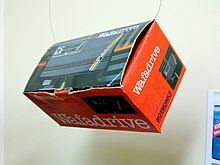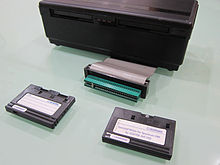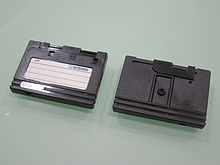
The Amstrad CPC is a series of 8-bit home computers produced by Amstrad between 1984 and 1990. It was designed to compete in the mid-1980s home computer market dominated by the Commodore 64 and the ZX Spectrum, where it successfully established itself primarily in the United Kingdom, France, Spain, and the German-speaking parts of Europe.
The Sinclair QL is a personal computer launched by Sinclair Research in 1984, as an upper-end counterpart to the ZX Spectrum.

A tape drive is a data storage device that reads and writes data on a magnetic tape. Magnetic-tape data storage is typically used for offline, archival data storage. Tape media generally has a favorable unit cost and a long archival stability.

The ZX Spectrum is an 8-bit home computer developed and marketed by Sinclair Research. It is one of the most influential computers ever made, and it is also one of the best selling computers ever, with over five million units sold. It was first released in the United Kingdom on 23 April 1982, and around the world in the following years, most notably in Europe, the United States, and Eastern Bloc countries.
The Multiface was a hardware peripheral released by Romantic Robot for several 1980s home computers. The primary function of the device was to dump the computer's memory to external storage. Pressing a red button on the Multiface activated it. As most games of the era did not have a save game feature, the Multiface allowed players to save their position by saving a loadable snapshot of the game. Home computer software of the early 1980s was typically loaded into RAM in one go, with copy protection measures concentrating the loading phase or just after it. The snapshot feature could be used after copy protection routines had been executed, to create a backup that was effectively unprotected against unauthorised distribution. Later models of the Multiface mitigated this by requiring the device to be present when re-loading the dumps into memory, making the dumps useless to people without a Multiface. Software producers also reacted to the threat by using routines that would prevent execution of the product if it detected that a Multiface was present and by loading the software in multiple parts, thus requiring the presence of the original, copy-protected media.
Miles Gordon Technology, known as MGT, was a small British company, initially specialising in high-quality add-ons for the ZX Spectrum home computer. It was founded in June 1986 in Cambridge, England by Alan Miles and Bruce Gordon, former employees of Sinclair Research, after Sinclair sold the rights for the Spectrum to Amstrad. They moved to Swansea, Wales, in May 1989, became a public company in July 1989 and went into receivership in June 1990.
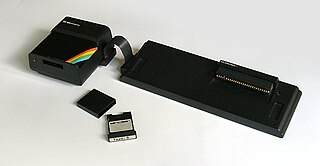
The ZX Interface 1, launched in 1983, was a peripheral from Sinclair Research for its ZX Spectrum home computer. Originally intended as a local area network interface for use in school classrooms, it was revised before launch to also act as the controller for up to eight ZX Microdrive high-speed tape-loop cartridge drives. It also included a DE-9 RS-232 interface capable of operating at up to 19.2 kbit/s. At hardware level it was fundamentally a voltage adaptor, the serial protocol being implemented in software by bit-banging. This led to problems when receiving data, but not when transmitting.

The Exatron Stringy Floppy is a continuous-loop tape drive developed by Exatron.

The ZX Microdrive is a magnetic-tape data storage system launched in July 1983 by Sinclair Research for its ZX Spectrum home computer. It was proposed as a faster-loading alternative to the cassette and cheaper than a floppy disk, but it suffered from poor reliability and lower speed.
Timex Sinclair was a joint venture established in December 1982 between the British company Sinclair Research and Timex Corporation in an effort to gain an entry into the rapidly growing early-1980s home computer market in North America.

The ZX Interface 2 is a peripheral from Sinclair Research for its ZX Spectrum home computer released in September 1983. It has two joystick ports and a ROM cartridge slot, which offers instant loading times. The joystick ports are not compatible with the popular Kempston interface, and thus do not work with most Spectrum games released prior to the launch of the ZX Interface 2. In addition, the pass-through expansion bus provided was stripped, only allowing a ZX Printer to be attached.

The ATM Turbo, also known simply as ATM is a ZX Spectrum clone, developed in Moscow in 1991, by two firms, MicroArt and ATM.

The Commodore 64 home computer used various external peripherals. Due to the backwards compatibility of the Commodore 128, most peripherals would also work on that system. There is also some compatibility with the VIC-20 and Commodore PET.

A fast loader is a software program for a home computer, such as the Commodore 64 or ZX Spectrum, that accelerates the speed of file loading from floppy disk or compact cassette.
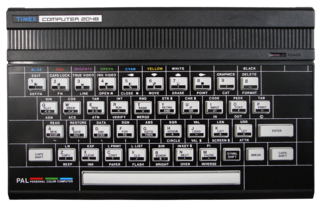
The Timex Computer 2048 or TC 2048 is a 1984 computer developed by Timex Portugal, at the time part of Timex Sinclair. It was based on the Timex Sinclair 2048 prototype, with a similar redesign case, composite video output, Kempston joystick interface, and additional video modes, while being highly compatible with the Sinclair ZX Spectrum computer.
The ZX Spectrum's software library was very diverse. While the majority of the software produced for the system was video games, others included programming language implementations, Sinclair BASIC extensions, databases, word processors, spread sheets, drawing and painting tools, and 3D modelling tools.

Home computers were a class of microcomputers that entered the market in 1977 and became common during the 1980s. They were marketed to consumers as affordable and accessible computers that, for the first time, were intended for the use of a single, non-technical user. These computers were a distinct market segment that typically cost much less than business, scientific, or engineering-oriented computers of the time, such as those running CP/M or the IBM PC, and were generally less powerful in terms of memory and expandability. However, a home computer often had better graphics and sound than contemporary business computers. Their most common uses were word processing, playing video games, and programming.
Commodore 64 disk/tape emulation and data transfer comprises hardware and software for Commodore 64 disk & tape emulation and for data transfer between either Commodore 64 (C64), Commodore (1541) disk drive or Commodore tape deck and newer computers.
The TC 3256 or Timex Computer 3256 was a 1987 computer created by Timex of Portugal, a branch of Timex Corporation.
